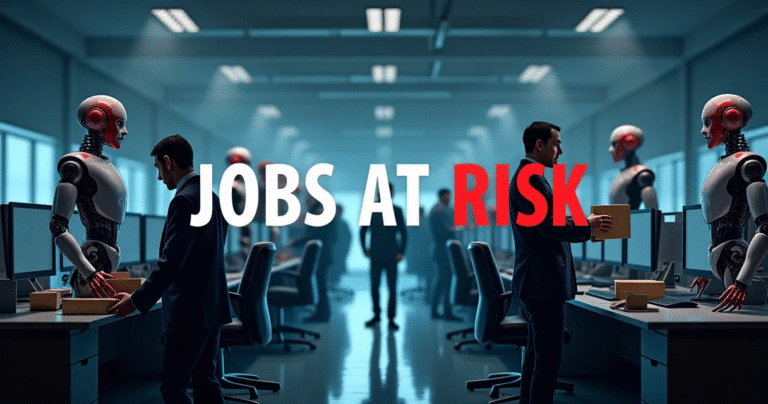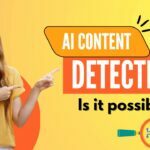AI’s Impact on the White-Collar Workforce
Artificial Intelligence is rapidly transforming employment landscapes, with significant implications for professional workers
Job Loss Projection
50% of entry-level white-collar jobs could disappear within five years due to AI automation and efficiency gains, fundamentally restructuring professional work environments.
Unemployment Risk
Experts warn of potential unemployment rates spiking to 10–20% in the U.S., with young professionals facing disproportionate impact as they compete for fewer entry positions.
High-Risk Sectors
Law, finance, technology, and marketing sectors face the greatest disruption from AI tools that can perform research, analysis, coding, and content creation tasks previously handled by junior staff.
Vulnerable Demographics
Early-career workers are most exposed to AI displacement as they lack the experience and judgment needed to effectively manage AI agents, while performing tasks most easily automated.
Proposed Solution
Anthropic CEO advocates implementing a “token tax” on AI companies’ revenue to fund support systems for displaced workers, including retraining programs and social safety nets.
Irony of Influence
A leader in AI development (Anthropic) warns about the technology’s societal risks despite driving its advancement, highlighting the complex ethical position of AI companies in managing consequences.
The conversation around Artificial Intelligence (AI) often paints a picture of unprecedented innovation and societal advancement. However, a stark warning from a prominent figure in the AI world has cast a significant shadow over this optimistic outlook, particularly concerning the future of white-collar jobs. Dario Amodei, the CEO of AI safety and research company Anthropic, has cautioned that AI could lead to a “job extinction” event, potentially wiping out as much as 50% of entry-level white-collar positions within the next five years and pushing unemployment rates to a staggering 20%. This isn’t just another tech headline; it’s a call to attention that resonates deeply within the tech community and beyond, prompting a critical examination of AI’s societal impact and the preparedness of our workforce.
Amodei’s pronouncements, largely made in an interview with Axios, suggest an economic upheaval unlike anything previously witnessed, driven by the rapid advancement of AI capabilities. He believes that many, including lawmakers and workers themselves, are “unaware that this is about to happen” or “just don’t believe it.” This article will explore the specifics of Amodei’s warning, the sectors most at risk, contrasting expert opinions, Anthropic’s own approach to responsible AI development, and the broader implications for society as we stand on the cusp of a potentially transformative, yet disruptive, era.
The “Amodei Tsunami”: What’s Behind the Stark Prediction?
Dario Amodei’s warning isn’t a casual remark; it’s a calculated forecast from someone at the forefront of AI development. Anthropic, the company he leads, is responsible for creating powerful AI models like Claude, placing Amodei in a unique position to understand the trajectory and potential impact of these technologies. He suggests that the pace of AI development is so rapid that its effects on the job market will be swift and significant.
Decoding the Numbers: 50% Job Loss and 20% Unemployment?
The core of Amodei’s concern lies in two striking figures:
📌 50% Elimination of Entry-Level White-Collar Jobs: This prediction focuses specifically on roles that are often the first step on the career ladder for many professionals. These jobs, he argues, are highly susceptible to automation by increasingly sophisticated AI systems.
📌 Potential for 20% Unemployment: Such a dramatic loss in entry-level positions, according to Amodei, could ripple through the economy, leading to overall unemployment rates hitting levels rarely seen in modern history. He paints a scenario where “Cancer is cured, the economy grows at 10 percent a year, the budget is balanced—and 20 percent of people don’t have jobs.”
These numbers are alarming and have understandably generated significant discussion. Amodei believes that AI’s capability to perform tasks currently handled by humans in these roles is advancing at an exponential rate. He even predicted that AI could be writing 90% of software code within six months and virtually all of it within a year, completely reshaping tech employment.
Which Sectors Are in the AI Crosshairs? 🎯
While the impact is predicted to be broad, Amodei highlighted several white-collar sectors as particularly vulnerable to this AI-driven transformation. These include:
- Technology: Ironically, the industry creating these AI tools may see significant shifts, especially in roles like entry-level coding, software testing, and data analysis.
- Finance: Tasks involving data processing, financial modeling, and even some aspects of customer service could be automated.
- Law: Document review, legal research, and drafting of basic legal documents are areas where AI is already making inroads.
- Consulting: Data gathering, analysis, and report generation, common in entry-level consulting, are prime candidates for AI augmentation or replacement.
The common thread among these roles is their reliance on information processing, pattern recognition, and routine tasks – all areas where AI is rapidly gaining proficiency.
Beyond the Headlines: Understanding the Nuance of AI’s Workplace Transformation
While the “job extinction” headline is attention-grabbing, it’s important to look at the nuances of how AI is expected to change the workplace. It’s not always a simple case of human out, AI in.
Not Just Replacement, But Augmentation Too?
Many experts, and even Amodei to some extent, acknowledge that AI will also augment human capabilities. This means AI tools could handle repetitive or time-consuming parts of a job, freeing up human workers to focus on more complex, creative, or strategic tasks. The World Economic Forum’s Future of Jobs Report 2023 (a hypothetical example as the actual 2025 report PDF wasn’t directly accessible in the search but the concept is relevant) often discusses this dual impact.
However, Amodei’s recent statements lean more heavily towards a significant replacement effect, especially in the short to medium term for certain job categories. He noted that while AI initially supports human tasks, this augmentation phase might be a short-term strategy before full automation takes over for many functions.
The “Entry-Level Squeeze”: Why Junior Roles Are Most Vulnerable
The emphasis on entry-level positions is crucial. These roles often involve tasks that are more structured, repetitive, and data-intensive, making them easier to automate with current AI technologies. This creates a significant challenge: if entry points into careers disappear, how will the next generation of professionals gain experience and develop their skills? This could disrupt the entire talent pipeline, affecting companies looking for skilled, experienced individuals in the future.
As one commentator on a Reddit thread discussing Amodei’s views pointed out, “If this wipes all the entry level white collar jobs how does anyone start out anymore? Everyone in the mid to senior level roles had a start at entry level.” This highlights a fundamental societal and economic question that needs addressing.
Voices from the Field: Expert Perspectives on AI and Employment

Dario Amodei isn’t alone in raising concerns, but the severity and timeline of his predictions are among the more alarming. The discourse around AI and job displacement is varied.
Echoes of Concern: Support for Amodei’s Outlook
Some analysts and industry observers share Amodei’s sense of urgency. They point to the rapid improvement in AI models’ abilities to write, code, analyze, and create, suggesting that the timeline for significant job displacement could indeed be short. Steve Bannon, former White House Chief Strategist, has also warned about AI “eviscerating” administrative, managerial, and tech jobs for younger workers. The argument is that AI tools are becoming cheaper, more efficient, and can work 24/7 without the needs and demands of human employees.
A More Measured View: Counterarguments and Cautious Optimism
Other experts, while acknowledging AI’s transformative potential, offer a more cautious or even optimistic perspective. They argue that:
👉 Historically, technological shifts have created new jobs: While some jobs become obsolete, new roles and industries emerge. The Industrial Revolution and the rise of the internet are often cited as examples.
👉 AI adoption takes time: Implementing AI effectively across various industries involves significant investment, organizational change, and overcoming technical hurdles. This might slow down the pace of job displacement.
👉 Focus on human-AI collaboration: Many see the future as one where humans work alongside AI, leveraging its strengths to enhance productivity and create new value.
👉 Current data doesn’t yet show mass displacement: Some economists point out that, despite the widespread availability of AI tools for a couple of years, employment data hasn’t yet reflected a massive AI-driven job loss. For instance, Menaka Hampole (Yale), Dimitris Papanikolaou (Northwestern), Lawrence D.W. Schmidt (MIT), and Bryan Seegmiller (Northwestern) in a recent paper, “Artificial Intelligence and the Labor Market,” found AI has had a limited impact on labor so far because the labor market adapts.
It’s a complex debate with valid points on all sides. The truth likely lies somewhere in between the most dire predictions and the most optimistic dismissals.
Anthropic’s Stance: Building AI Responsibly Amidst a Shifting Landscape
It’s noteworthy that these stark warnings come from the CEO of a company actively building these powerful AI systems. This places Anthropic in a somewhat paradoxical position.
A “Duty to be Honest”: Anthropic’s Call for Transparency
Amodei has stated that “We, as the producers of this technology, have a duty and an obligation to be honest about what is coming.” He believes AI companies and governments need to stop “sugar-coating” the potential for massive job displacement. His aim in speaking out is to jar policymakers, fellow AI companies, and the public into preparing for these changes. He feels that most people are not on a “war footing” regarding the potential societal disruption.
Beyond Warnings: Anthropic’s Approach to Safe AI Development
Anthropic itself emphasizes responsible AI development. The company was founded by former OpenAI members with a strong focus on AI safety and alignment. They have published a Responsible Scaling Policy (RSP) which outlines protocols to manage the risks of increasingly capable AI. This policy includes AI Safety Levels (ASLs), modeled after biosafety levels, to ensure appropriate safety and security measures are in place as models become more powerful.
Their approach includes:
✅ Constitutional AI: Training AI models using a set of guiding principles or a “constitution” to ensure they align with human values and ethical standards.
✅ Interpretability Research: Working to “open the black box” of AI models to understand their decision-making processes better.
✅ Focus on Catastrophic Risk Mitigation: While the job displacement issue is a significant societal risk, Anthropic’s RSP primarily focuses on preventing large-scale devastation from misuse or uncontrolled AI.
✅ Collaboration and Public Awareness: Anthropic has partnered with institutions like Northeastern University to explore responsible AI integration in education and has achieved ISO 42001 certification for its AI management system, underscoring its commitment to safety.
This commitment to responsible development, juxtaposed with Amodei’s dire job market predictions, highlights the complex tightrope AI companies are walking. They are driven by competitive pressures to innovate, yet increasingly aware of the profound societal implications of their creations.
Peering Into the Crystal Ball: Where Do We Go From Here? 🔮
Amodei’s warnings, whether they prove to be entirely accurate in their timeline and scale or not, serve as a crucial catalyst for discussion and action. The question is no longer if AI will impact jobs, but how and how quickly, and what we can do to navigate this transition.
The Urgency of Adaptation: Reskilling and Policy Considerations
If even a fraction of Amodei’s predictions come true, the societal impact will be immense. This underscores the urgent need for:
📌 Education and Reskilling Initiatives: Individuals will need to adapt and acquire new skills that are complementary to AI, focusing on creativity, critical thinking, emotional intelligence, and complex problem-solving – areas where humans still hold an edge.
📌 Policy Interventions: Governments may need to consider a range of policy responses. Amodei himself has suggested ideas like a “token tax” on AI companies to fund retraining programs and social safety nets. Other discussions revolve around Universal Basic Income (UBI), shorter work weeks, and investments in sectors less prone to automation.
📌 Ethical Frameworks: Developing and implementing robust ethical guidelines for AI development and deployment is crucial to ensure fairness, transparency, and accountability.
A Double-Edged Sword: Balancing AI’s Promise and Peril
Amodei’s own words capture the paradoxical nature of advanced AI: “Cancer is cured, the economy grows at 10 percent a year, the budget is balanced—and 20 percent of people don’t have jobs.” This illustrates the immense potential benefits of AI in areas like healthcare, scientific discovery, and economic productivity, set against the significant challenge of widespread job displacement and increased inequality.
The challenge lies in harnessing AI’s power for good while proactively mitigating its negative consequences. This requires a multi-stakeholder approach involving AI developers, businesses, governments, educational institutions, and individuals.
Comparison: Potential AI Impact Scenarios
| Scenario | Description | Potential Upsides | Potential Downsides |
|---|---|---|---|
| Rapid Displacement (Amodei-like) | AI quickly automates a large percentage of routine white-collar tasks, leading to high unemployment. | Rapid productivity gains, solutions to major problems | Mass unemployment, social unrest, economic inequality |
| Gradual Transition & Adaptation | AI adoption is slower; workforce has time to reskill; new jobs emerge to complement AI. | Smoother economic adjustment, enhanced human work | Some job displacement, need for continuous learning |
| Augmentation Dominance | AI primarily serves as a tool to assist humans, making them more productive but not replacing them outright. | Increased efficiency, higher quality work | Potential for skill gaps if augmentation is not embraced |
The Unfolding Narrative: Preparing for an AI-Shaped Tomorrow
Dario Amodei’s stark predictions about AI leading to a “job extinction” for 50% of entry-level white-collar roles are a critical wake-up call. While the exact future remains unwritten, the trends in AI development suggest that significant changes to the labor market are inevitable. Ignoring these warnings would be shortsighted.
The path forward involves acknowledging the potential disruption, fostering open dialogue, investing in education and reskilling, and developing thoughtful policies. It’s about preparing for a future where human skills are augmented by AI, new roles emerge, and society adapts to a new economic reality. The conversation initiated by Amodei and others in the field is not just about technology; it’s about the future of work, the structure of our society, and how we ensure that the benefits of AI are shared broadly, rather than exacerbating existing inequalities. The narrative of AI and employment is still unfolding, and our collective actions today will shape its chapters for years to come.







